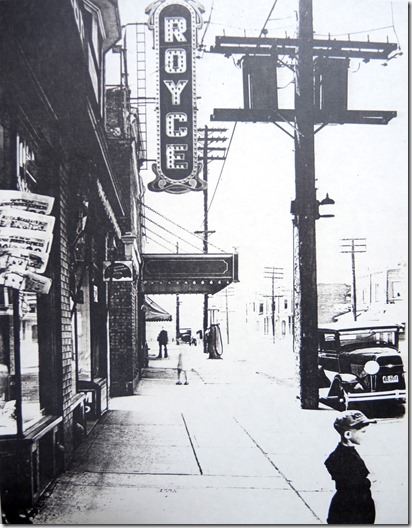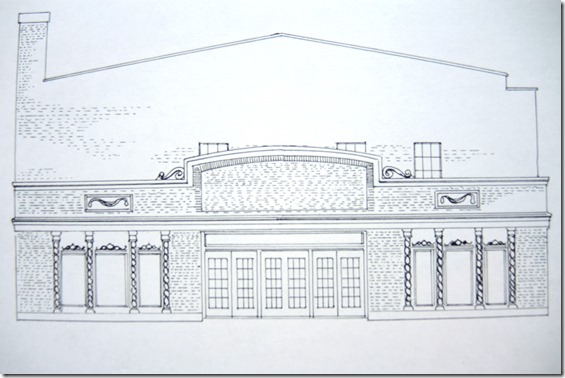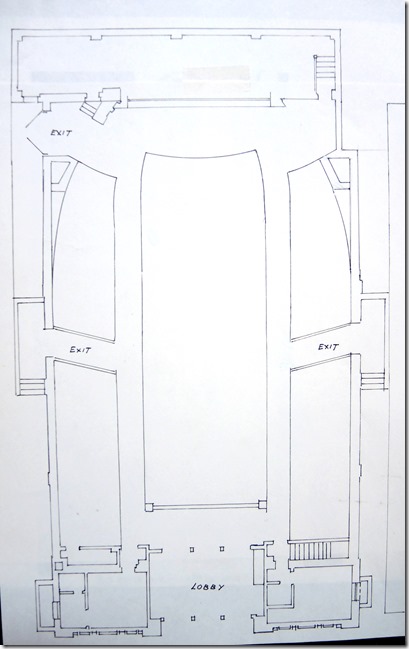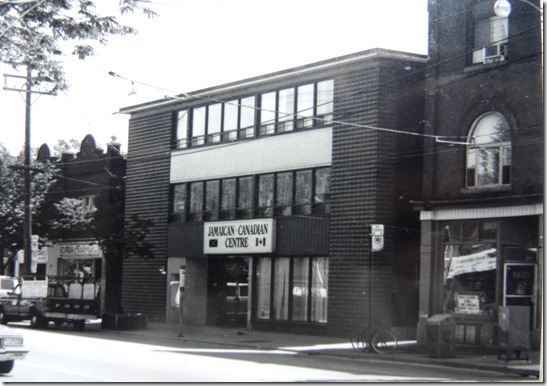The Royce Theatre c. 1920, gazing west along Dupont Street. A gasoline pump is on the sidewalk to the west of the theatre. A person wonders what has attracted the attention of the young boy in the foreground. Photo from The City of Toronto Archives.
Researching the old Royce Theatre was difficult, since not much information was available. However, from the photos and the floor plan of it in the Toronto Archives I was able to piece together some data about the old theatre.
I was unable to discover the exact year it opened, but I would estimate that it was in the teen years of the 20th century or possibly as late as 1920. Originally, its address was 315 Royce Avenue, hence the theatre’s name. However, after the city joined together Royce Avenue with several others roadways, it was named Dupont Street. The address of the theatre then became 1619 Dupont Street. Located on the south side of the street, it was between Edwin and Franklin Avenues, a few blocks east of the junction of three main arterial roadways—Dupont, Annette and Dundas West. Because the theatre was within walking distance of the theatres in the Junction District (at Dundas West and Keele Streets), it competed for patrons with theatres such as the Mavity and Beaver.
Dupont Street was built parallel to the CPR Railway tracks, located not far to the north of it. In the early decades of the 20th century, factories located on the street as it possessed easy access to the rail lines. However, though it developed as an industrial area, many shops also lined the street. They supported the residential neighbourhoods to the north and south of it. The Royce Theatre was built to service the cinematic needs of these neighbourhoods.
The community also possessed relatively easy access to downtown Toronto, since there was a streetcar line on Dupont Street. It was replaced by a trolley line, which I remember riding in the 1950s. From the trolley window, I recall seeing Royce Dupont Poultry and Egg Market, but being a teenager at the time, I did not realize that the word Royce was derived from the former name of the street. Today, a bus route services Dupont Street.
The Dupont Theatre was originally a vaudeville house, although its stage was too narrow to accommodate moveable scenery. The vaudeville performances were supplemented with silent movies. In front of the stage was space for a small group of musicians. The auditorium possessed 587 plush seats, but no balcony. There was a wide centre section of seating and and two side-aisles, one on either side of it. The lobby was small, with office and storage space on either side of it.
The brick facade was symmetrical, with restrained but attractive detailing. Its design reflected the styles of the early years of the 20th century, rather than the mid or late 1920s. There were large display spaces facing the street, to the left and right of the entrance doors. The windows on the second-storey did not appear to be for residential apartments as they were quite small and not evenly distributed. The sign above the marquee was large and flashy, with enormous vertical letters indicating the name of the theatre. The canopy containing the marquee was rectangular and plain.
A candy bar was installed in the Royce in 1947, in the centre of the lobby, just 2 feet inside the front doors. This was unusual, but the small size of the lobby necessitated this location. I suppose the management did not wish to remove any seats as the theatre was small, every seat needed to generate income.
I did not discover the year the theatre shut its doors, but it was likely in the late 1950s or early 1960s. After it closed, the site became the home of the Canadian Jamaican Centre.
Sketch of the facade of the Royce Theatre. The blank spaces between the columns to the left and right of the doors were likely for posters advertising films that were showing and future attractions. There does not appear to be a canopy over the doorway. City of Toronto Archives.
Sketch of the floor plan of the theatre. The stairs near the right-hand side of the lobby likely allowed access to the washrooms in the basement. Sketch from The City of Toronto Archives.
The site of the Royce Theatre on Dupont Street when it was the Canadian Jamaican Centre. Photo, City of Toronto Archives.
To view the Home Page for this blog: https://tayloronhistory.com/
To view previous blogs about movie houses of Toronto—historic and modern
Recent publication entitled “Toronto’s Theatres and the Golden Age of the Silver Screen,” by the author of this blog. The publication explores 50 of Toronto’s old theatres and contains over 80 archival photographs of the facades, marquees and interiors of the theatres. It relates anecdotes and stories of the author and others who experienced these grand old movie houses.
To place an order for this book:
Book also available in Chapter/Indigo, the Bell Lightbox Book Store and by phoning University of Toronto, Press Distribution: 416-667-7791
Theatres Included in the Book:
Chapter One – The Early Years—Nickelodeons and the First Theatres in Toronto
Theatorium (Red Mill) Theatre—Toronto’s First Movie Experience and First Permanent Movie Theatre, Auditorium (Avenue, PIckford), Colonial Theatre (the Bay), the Photodome, Revue Theatre, Picture Palace (Royal George), Big Nickel (National, Rio), Madison Theatre (Midtown, Capri, Eden, Bloor Cinema, Bloor Street Hot Docs), Theatre Without a Name (Pastime, Prince Edward, Fox)
Chapter Two – The Great Movie Palaces – The End of the Nickelodeons
Loew’s Yonge Street (Elgin/Winter Garden), Shea’s Hippodrome, The Allen (Tivoli), Pantages (Imperial, Imperial Six, Ed Mirvish), Loew’s Uptown
Chapter Three – Smaller Theatres in the pre-1920s and 1920s
Oakwood, Broadway, Carlton on Parliament Street, Victory on Yonge Street (Embassy, Astor, Showcase, Federal, New Yorker, Panasonic), Allan’s Danforth (Century, Titania, Music Hall), Parkdale, Alhambra (Baronet, Eve), St. Clair, Standard (Strand, Victory, Golden Harvest), Palace, Bedford (Park), Hudson (Mount Pleasant), Belsize (Crest, Regent), Runnymede
Chapter Four – Theatres During the 1930s, the Great Depression
Grant ,Hollywood, Oriole (Cinema, International Cinema), Eglinton, Casino, Radio City, Paramount, Scarboro, Paradise (Eve’s Paradise), State (Bloordale), Colony, Bellevue (Lux, Elektra, Lido), Kingsway, Pylon (Royal, Golden Princess), Metro
Chapter Five – Theatres in the 1940s – The Second World War and the Post-War Years
University, Odeon Fairlawn, Vaughan, Odeon Danforth, Glendale, Odeon Hyland, Nortown, Willow, Downtown, Odeon Carlton, Donlands, Biltmore, Odeon Humber, Town Cinema
Chapter Six – The 1950s Theatres
Savoy (Coronet), Westwood
Chapter Seven – Cineplex and Multi-screen Complexes
Cineplex Eaton Centre, Cineplex Odeon Varsity, Scotiabank Cineplex, Dundas Square Cineplex, The Bell Lightbox (TIFF)




![cid_E474E4F9-11FC-42C9-AAAD-1B66D852[1] cid_E474E4F9-11FC-42C9-AAAD-1B66D852[1]](https://tayloronhistory.com/wp-content/uploads/2014/12/cid_e474e4f9-11fc-42c9-aaad-1b66d8521_thumb.jpg)


Actually when it closed it became the “Croatian Home”. Then Jamaican Centre.
Currently it is Canadian Mederios Centre